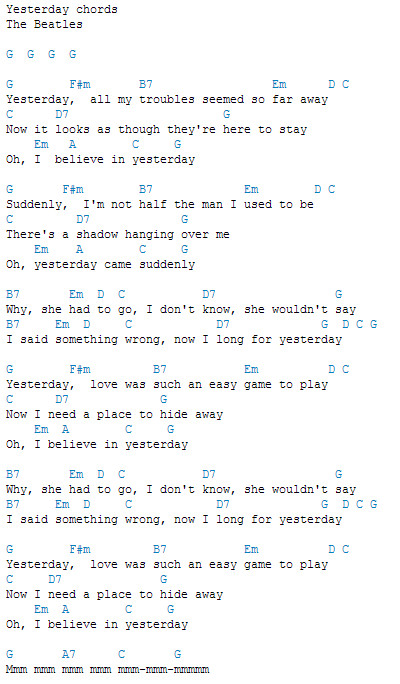“Yesterday,” a timeless ballad credited to Lennon-McCartney but crafted solely by Paul McCartney, resonates deeply with music lovers worldwide. Its enduring appeal is evident in over 2,000 cover versions, solidifying its place as one of the most covered songs in music history. For guitarists, “Yesterday” is a must-learn, a beautiful piece that showcases melodic simplicity and emotional depth. Whether you’re a beginner or an experienced player, mastering “Yesterday” on guitar is a rewarding musical journey.
Get the Guitar Notes and Tab for Yesterday
Ready to dive into the beautiful melodies of “Yesterday”? We’ve made it easy for you to access the complete guitar tab. This detailed transcription will guide you through every note, ensuring you capture the nuances of McCartney’s original guitar part. Download the full “Yesterday” guitar tab in PDF format to start learning this iconic song today.
Easy Strumming Version with Chords
For those who prefer a simpler approach or want to accompany their singing, a strumming version of “Yesterday” is perfect. This version focuses on chords and lyrics, making it accessible for guitarists of all levels. The visual chord chart below provides a quick and easy way to grasp the basic harmonic structure of the song. Click on the image to open a printable version, allowing you to have the chords and lyrics readily available as you practice.
Yesterday guitar chords diagram, illustrating the basic chord shapes for playing a strumming version of the song.
Understanding the Music Theory Behind Yesterday
“Yesterday” is played by McCartney on an Epiphone Texan acoustic guitar and is characterized by its contrasting sections, each with its distinct melodic and rhythmic feel. The song’s structure, while seemingly simple, employs clever compositional techniques that contribute to its melancholic yet captivating aura.
The song opens in F major, but quickly veers into D minor, creating a sense of harmonic surprise. As musicologist Alan Pollack notes, this “delayed gratification” is a hallmark of Lennon and McCartney’s songwriting. The opening chord progression, starting with an F chord (with the 3rd omitted), moving to Em7, then A7, and finally resolving to D minor, exemplifies this technique. The use of Em7 and A7, a ii-V7 progression, leading to D minor, is crucial in establishing the song’s signature melancholy feel. The A7 chord serves as a secondary dominant (V/vi), further enriching the harmonic texture.
The bridge section (“Why she had to go I don’t know…”) offers a contrasting musical journey. It starts with Em7 and progresses through A major, D minor, and Bb, before returning to F major. The G7 chord in the bridge acts as another secondary dominant (V/V), but instead of resolving as expected, it moves to the IV chord (Bb), creating a descending chromatic line (C–B–Bb–A) that beautifully underscores the title lyric “Yesterday.”
By understanding these musical elements, guitarists can gain a deeper appreciation for “Yesterday” and enhance their performance of this timeless classic.

